Net Transport Patterns of Surficial Marine Sediments in the North Aegean Sea, Greece
Abstract
:1. Introduction
2. Materials and Methods
2.1. Study Area
2.2. Sampling Effort and Laboratory Testing

3. Results
3.1. Grain Size Analyses
3.2. Grain Size Parameters
3.3. Sediment Transport Patterns
4. Discussion
4.1. North Aegean Water Circulation Pattern
4.2. Water Circulation Pattern and Sediment Transport
5. Conclusions
Author Contributions
Funding
Institutional Review Board Statement
Informed Consent Statement
Data Availability Statement
Acknowledgments
Conflicts of Interest
Appendix A
| ID | x | y | Mean | Sort | Skew |
|---|---|---|---|---|---|
| 1 | 564,117 | 4,495,734 | 2.12 | 0.21 | 1.29 |
| 2 | 565,142 | 4,499,443 | 2.51 | 0.41 | 0.1 |
| 3 | 564,877 | 4,502,987 | 0.47 | 0.45 | −0.25 |
| 4 | 664,621 | 4,521,654 | 3.5 | 0.48 | 0.06 |
| 5 | 561,735 | 4,513,753 | 2.51 | 0.52 | −0.02 |
| 6 | 662,132 | 4,522,987 | 3.5 | 0.55 | 0.03 |
| 7 | 572,623 | 4,526,958 | 1.3 | 0.59 | −0.11 |
| 8 | 564,133 | 4,507,607 | 3.06 | 0.61 | −0.11 |
| 9 | 561,072 | 4,494,629 | 2.75 | 0.62 | 0.2 |
| 10 | 571,002 | 4,525,247 | 3.17 | 0.63 | −0.15 |
| 11 | 604,855 | 4,531,510 | 3.42 | 0.65 | −0.06 |
| 12 | 622,224 | 4,528,077 | −0.85 | 0.68 | 0.61 |
| 13 | 568,684 | 4,522,757 | 2.65 | 0.68 | 0.03 |
| 14 | 584,505 | 4,531,557 | 0.14 | 0.72 | −0.08 |
| 15 | 632,223 | 4,485,682 | −0.05 | 0.77 | −1.09 |
| 16 | 627,886 | 4,484,681 | −0.39 | 0.81 | 0.19 |
| 17 | 538,723.7 | 4,468,109 | 5.83 | 0.82 | 0.38 |
| 18 | 530,532.2 | 4,481,180 | 6.44 | 0.86 | 0.2 |
| 19 | 620,525 | 4,518,866 | 7.08 | 0.89 | −0.23 |
| 20 | 520,544.2 | 4,481,179 | 6.47 | 0.97 | 0.2 |
| 21 | 653,457 | 4,523,264 | 3.98 | 0.99 | 0.32 |
| 22 | 543,395.6 | 4,475,578 | 6.34 | 1.11 | 0.26 |
| 23 | 515,674.6 | 4,474,244 | 6.34 | 1.12 | 0.04 |
| 24 | 536,425.5 | 4,486,993 | 6.92 | 1.12 | −0.52 |
| 25 | 539,524.2 | 4,480,960 | 5.95 | 1.13 | 0.43 |
| 26 | 576,686 | 4,530,084 | 2.84 | 1.15 | −0.61 |
| 27 | 599,227 | 4,497,661 | 7.16 | 1.15 | −0.16 |
| 28 | 643,503 | 4,480,647 | −0.04 | 1.16 | 0.43 |
| 29 | 516,552.9 | 4,481,735 | 6.22 | 1.17 | −0.11 |
| 30 | 621,283 | 4,521,277 | 7.3 | 1.18 | 0.05 |
| 31 | 620,447 | 4,521,096 | 7.31 | 1.18 | 0.03 |
| 32 | 521,826.1 | 4,477,227 | 6.46 | 1.18 | 0.15 |
| 33 | 580,491 | 4,479,024 | 6.82 | 1.19 | 0.09 |
| 34 | 524,872.9 | 4,473,734 | 6.18 | 1.19 | 0.21 |
| 35 | 507,686.6 | 4,486,452 | 6.54 | 1.19 | 0.12 |
| 36 | 579,912 | 4,491,104 | 5.86 | 1.25 | −0.39 |
| 37 | 614,096 | 4,525,320 | 7.23 | 1.26 | −0.12 |
| 38 | 545,347.7 | 4,469,495 | 5.98 | 1.27 | 0.31 |
| 39 | 650,533 | 4,477,987 | 1.67 | 1.28 | 0.19 |
| 40 | 565,173 | 4,522,571 | 3.04 | 1.28 | 0.26 |
| 41 | 504,645.3 | 4,493,972 | 7 | 1.28 | −0.18 |
| 42 | 573,619 | 4,475,900 | 7.21 | 1.29 | 0 |
| 43 | 617,571 | 4,521,085 | 7.22 | 1.31 | −0.11 |
| 44 | 531,091.4 | 4,468,284 | 6.05 | 1.32 | 0.32 |
| 45 | 597,344 | 4,479,903 | 6.98 | 1.34 | −0.2 |
| 46 | 668,092 | 4,518,492 | 3.95 | 1.35 | 0.54 |
| 47 | 657,933 | 4,522,124 | 3.97 | 1.36 | 0.57 |
| 48 | 660,789 | 4,520,088 | 4.38 | 1.37 | 0.47 |
| 49 | 491,560.1 | 4,477,278 | 7.18 | 1.37 | 0.01 |
| 50 | 664,646 | 4,514,250 | 7.51 | 1.38 | −0.09 |
| 51 | 492,158.7 | 4,493,472 | 7.16 | 1.38 | −0.07 |
| 52 | 512,381.4 | 4,495,458 | 6.82 | 1.4 | 0.18 |
| 53 | 481,810.7 | 4,509,859 | 7.33 | 1.41 | 0.11 |
| 54 | 522,251.5 | 4,500,630 | 6.28 | 1.42 | 0.24 |
| 55 | 656,900 | 4,515,623 | 8.08 | 1.43 | −0.21 |
| 56 | 487,873.2 | 4,482,525 | 7 | 1.44 | −0.19 |
| 57 | 657,604 | 4,521,038 | 4.29 | 1.45 | 0.56 |
| 58 | 631,609 | 4,472,824 | 1.22 | 1.46 | 0.38 |
| 59 | 626,452 | 4,518,931 | 6.86 | 1.46 | −0.37 |
| 60 | 635,417 | 4,484,814 | 0.92 | 1.48 | 0.45 |
| 61 | 591,374 | 4,534,106 | 1.05 | 1.49 | 0.17 |
| 62 | 558,846 | 4,493,686 | 4.46 | 1.49 | 0.42 |
| 63 | 554,411.7 | 4,469,214 | 6.58 | 1.49 | 0.29 |
| 64 | 535,054.8 | 4,475,005 | 6.42 | 1.5 | 0.24 |
| 65 | 542,773.5 | 4,511,316 | 2.24 | 1.51 | 0.03 |
| 66 | 587,523 | 4,475,865 | 5.86 | 1.54 | −0.28 |
| 67 | 522,080 | 4,486,185 | 6.88 | 1.55 | −0.04 |
| 68 | 663,687 | 4,516,233 | 7.15 | 1.57 | −0.06 |
| 69 | 598,300 | 4,532,038 | 0.04 | 1.58 | 0.03 |
| 70 | 586,382 | 4,490,871 | 7.45 | 1.58 | −0.03 |
| 71 | 668,183 | 4,514,483 | 7.52 | 1.58 | −0.04 |
| 72 | 566,111 | 4,496,214 | 3.08 | 1.59 | 0.35 |
| 73 | 478,119.4 | 4,507,424 | 7.23 | 1.59 | −0.05 |
| 74 | 594,319 | 4,495,593 | 6.25 | 1.6 | −0.16 |
| 75 | 585,973 | 4,495,801 | 6.93 | 1.6 | −0.31 |
| 76 | 496,246.8 | 4,503,711 | 6.83 | 1.61 | −0.17 |
| 77 | 495,485.8 | 4,497,867 | 7.03 | 1.62 | −0.21 |
| 78 | 575,958 | 4,521,287 | 7.62 | 1.63 | −0.15 |
| 79 | 647,569 | 4,483,503 | 7.38 | 1.67 | −0.11 |
| 80 | 508,892 | 4,493,121 | 6.68 | 1.67 | 0.24 |
| 81 | 648,567 | 4,471,734 | 6.87 | 1.68 | 0.22 |
| 82 | 608,251 | 4,531,252 | 0.31 | 1.69 | 0.2 |
| 83 | 630,399 | 4,521,338 | 6.32 | 1.69 | −0.67 |
| 84 | 501,636.3 | 4,500,436 | 6.99 | 1.69 | −0.11 |
| 85 | 666,081 | 4,516,162 | 7.56 | 1.7 | −0.34 |
| 86 | 487,496.9 | 4,466,948 | 4.91 | 1.7 | 0.35 |
| 87 | 516,467.1 | 4,506,008 | 6.62 | 1.7 | 0.01 |
| 88 | 632,470 | 4,523,336 | 6.45 | 1.71 | −0.06 |
| 89 | 508,583.4 | 4,475,158 | 6.08 | 1.71 | −0.1 |
| 90 | 650,488 | 4,519,531 | 7.79 | 1.72 | −0.29 |
| 91 | 648,645 | 4,488,614 | 7.86 | 1.72 | −0.33 |
| 92 | 612,766 | 4,518,982 | 8.31 | 1.72 | −0.68 |
| 93 | 513,830 | 4,499,073 | 6.92 | 1.72 | −0.04 |
| 94 | 571,450 | 4,522,476 | 7.06 | 1.73 | −0.05 |
| 95 | 480,993.8 | 4,502,872 | 7.03 | 1.73 | −0.16 |
| 96 | 666,463 | 4,512,746 | 7.56 | 1.74 | −0.41 |
| 97 | 660,582 | 4,516,689 | 7.67 | 1.74 | −0.27 |
| 98 | 594,415 | 4,488,039 | 8.24 | 1.74 | −0.66 |
| 99 | 511,084.8 | 4,492,952 | 6.18 | 1.74 | −0.11 |
| 100 | 641,097 | 4,482,959 | 0.93 | 1.75 | 0.42 |
| 101 | 563,372 | 4,494,956 | 3.45 | 1.75 | 0.47 |
| 102 | 565,626 | 4,497,906 | 3.78 | 1.75 | 0.34 |
| 103 | 495,900.1 | 4,482,883 | 2.15 | 1.75 | 0.25 |
| 104 | 632,567 | 4,516,899 | 2.83 | 1.78 | 0.28 |
| 105 | 614,182 | 4,518,784 | 6.83 | 1.78 | −0.31 |
| 106 | 524,392 | 4,490,001 | 1.78 | 1.78 | 0.37 |
| 107 | 494,219.2 | 4,509,572 | 5.87 | 1.78 | 0.28 |
| 108 | 614,211 | 4,516,588 | 6.14 | 1.79 | −0.42 |
| 109 | 519,773.5 | 4,469,054 | 5.27 | 1.79 | −0.33 |
| 110 | 496,666.2 | 4,474,488 | 7.06 | 1.8 | −0.08 |
| 111 | 519,143 | 4,472,329 | 6.55 | 1.81 | 0.2 |
| 112 | 547,067.3 | 4,482,398 | 1.52 | 1.82 | 0.29 |
| 113 | 535,175.7 | 4,500,982 | 2.32 | 1.83 | 0.23 |
| 114 | 512,642.3 | 4,474,267 | 6.5 | 1.83 | 0.03 |
| 115 | 661,975 | 4,519,435 | 4.66 | 1.84 | 0.63 |
| 116 | 667,413 | 4,517,396 | 7.16 | 1.84 | −0.04 |
| 117 | 511,540.7 | 4,469,297 | 5.56 | 1.84 | −0.23 |
| 118 | 647,640 | 4,509,570 | 2.6 | 1.86 | 0.27 |
| 119 | 578,494 | 4,491,862 | 6.66 | 1.86 | −0.46 |
| 120 | 574,990 | 4,524,299 | 7.13 | 1.86 | 0.13 |
| 121 | 630,052 | 4,522,196 | 7.83 | 1.87 | −0.37 |
| 122 | 556,389 | 4,523,023 | 6.03 | 1.89 | −0.16 |
| 123 | 623,600 | 4,521,188 | 6.79 | 1.89 | 0.14 |
| 124 | 630,593 | 4,516,862 | 2.78 | 1.9 | 0.21 |
| 125 | 664,328 | 4,519,024 | 6.48 | 1.9 | 0.32 |
| 126 | 610,969 | 4,529,442 | 7.29 | 1.9 | −0.1 |
| 127 | 528,753.8 | 4,506,074 | 1.39 | 1.9 | 0.3 |
| 128 | 611,368 | 4,516,528 | 6.69 | 1.91 | −0.52 |
| 129 | 570,588 | 4,495,021 | 7.29 | 1.91 | −0.22 |
| 130 | 655,432 | 4,518,522 | 7.33 | 1.91 | −0.04 |
| 131 | 562,258 | 4,521,312 | 7.03 | 1.92 | 0.09 |
| 132 | 541,984.6 | 4,506,608 | 2.05 | 1.92 | 0.05 |
| 133 | 635,420 | 4,516,931 | 2.85 | 1.93 | 0.35 |
| 134 | 563,884 | 4,522,714 | 5.14 | 1.93 | 0.46 |
| 135 | 655,327 | 4,476,332 | 1.94 | 1.94 | 0.34 |
| 136 | 488,431 | 4,511,368 | 7.35 | 1.94 | 0.07 |
| 137 | 655,058 | 4,502,781 | 1.69 | 1.95 | 0.17 |
| 138 | 561,205 | 4,492,780 | 6.75 | 1.95 | −0.32 |
| 139 | 577,404 | 4,528,550 | 3.64 | 1.96 | 0.66 |
| 140 | 506,877.7 | 4,491,552 | 6.36 | 1.96 | −0.06 |
| 141 | 565,310 | 4,520,260 | 6.21 | 2.01 | 0.41 |
| 142 | 564,144 | 4,519,787 | 6.86 | 2.01 | 0.06 |
| 143 | 568,149 | 4,517,201 | 6.89 | 2.01 | 0.06 |
| 144 | 666,286 | 4,520,610 | 7.36 | 2.01 | −0.23 |
| 145 | 665,721 | 4,519,672 | 6.76 | 2.02 | 0.25 |
| 146 | 487,116.7 | 4,493,485 | 6.74 | 2.02 | −0.35 |
| 147 | 610,429 | 4,469,538 | 0.94 | 2.03 | 0.14 |
| 148 | 611,256 | 4,522,984 | 7.42 | 2.05 | −0.01 |
| 149 | 604,820 | 4,525,805 | 2.42 | 2.08 | −0.05 |
| 150 | 622,653 | 4,509,270 | 2.46 | 2.08 | 0.28 |
| 151 | 647,168 | 4,521,439 | 7.21 | 2.08 | −0.12 |
| 152 | 508,000.7 | 4,504,417 | 6.46 | 2.08 | −0.27 |
| 153 | 495,954.8 | 4,490,603 | 6.77 | 2.1 | −0.27 |
| 154 | 514,094.7 | 4,471,404 | 5.37 | 2.11 | −0.39 |
| 155 | 563,198 | 4,493,413 | 6.66 | 2.12 | −0.28 |
| 156 | 592,967 | 4,519,015 | 3.16 | 2.13 | 0.25 |
| 157 | 558,864 | 4,491,374 | 4.03 | 2.13 | 0.68 |
| 158 | 562,284 | 4,490,167 | 6.13 | 2.14 | −0.47 |
| 159 | 640,251 | 4,473,889 | 3.55 | 2.17 | 0.54 |
| 160 | 659,649 | 4,518,612 | 6.34 | 2.17 | 0.35 |
| 161 | 555,381.1 | 4,476,142 | 5.65 | 2.17 | −0.25 |
| 162 | 632,126 | 4,510,975 | 3.2 | 2.2 | 0.48 |
| 163 | 613,319 | 4,490,460 | 6.41 | 2.2 | −0.39 |
| 164 | 626,330 | 4,523,199 | 7.01 | 2.2 | −0.06 |
| 165 | 517,027.2 | 4,494,024 | 5.41 | 2.2 | −0.27 |
| 166 | 518,255.9 | 4,487,260 | 3.95 | 2.2 | 0.51 |
| 167 | 653,480 | 4,510,892 | 1.95 | 2.21 | 0.33 |
| 168 | 653,369 | 4,521,874 | 5.97 | 2.22 | 0.57 |
| 169 | 521,592.5 | 4,489,595 | 5.52 | 2.23 | −0.2 |
| 170 | 573,213 | 4,526,501 | 6.53 | 2.26 | 0.13 |
| 171 | 645,558 | 4,478,932 | 0.77 | 2.27 | 0.55 |
| 172 | 648,115 | 4,503,411 | 1.92 | 2.27 | 0.14 |
| 173 | 585,313 | 4,502,114 | 5.61 | 2.3 | −0.2 |
| 174 | 566,119 | 4,521,655 | 5.86 | 2.32 | 0.44 |
| 175 | 653,055 | 4,497,342 | 1.61 | 2.33 | 0.35 |
| 176 | 557,240 | 4,488,739 | 6.92 | 2.33 | −0.27 |
| 177 | 652,048 | 4,499,290 | 1.51 | 2.34 | 0.92 |
| 178 | 659,594 | 4,510,281 | 2.53 | 2.35 | 0.33 |
| 179 | 522,659.1 | 4,493,944 | 3.93 | 2.36 | 0.19 |
| 180 | 632,512 | 4,519,078 | 4.53 | 2.39 | 0.29 |
| 181 | 611,622 | 4,532,691 | 5.91 | 2.39 | 0.19 |
| 182 | 530,854.5 | 4,492,842 | 3.33 | 2.39 | 0.45 |
| 183 | 623,743 | 4,516,775 | 4.12 | 2.41 | 0.56 |
| 184 | 604,936 | 4,484,479 | 4.65 | 2.41 | 0.42 |
| 185 | 573,729 | 4,498,731 | 5.56 | 2.43 | −0.24 |
| 186 | 591,669 | 4,538,582 | 6.54 | 2.43 | 0.17 |
| 187 | 511,161.2 | 4,500,122 | 5.34 | 2.44 | −0.36 |
| 188 | 567,463 | 4,502,548 | 2.81 | 2.45 | 0.66 |
| 189 | 579,136 | 4,519,779 | 3.63 | 2.45 | 0.49 |
| 190 | 642,988 | 4,519,506 | 5.52 | 2.45 | −0.26 |
| 191 | 622,254 | 4,497,850 | 7.11 | 2.45 | −0.42 |
| 192 | 638,909 | 4,518,349 | 3.83 | 2.46 | 0.56 |
| 193 | 620,555 | 4,516,660 | 5.32 | 2.46 | −0.3 |
| 194 | 620,429 | 4,525,387 | 1.71 | 2.48 | −0.1 |
| 195 | 635,385 | 4,519,172 | 4.27 | 2.49 | 0.31 |
| 196 | 556,978 | 4,492,129 | 4.95 | 2.49 | 0.61 |
| 197 | 630,509 | 4,519,024 | 5.57 | 2.5 | −0.34 |
| 198 | 591,201 | 4,529,171 | 6.93 | 2.5 | −0.17 |
| 199 | 637,608 | 4,467,992 | 7.56 | 2.5 | 0.25 |
| 200 | 604,362 | 4,508,527 | 3.27 | 2.51 | 0.52 |
| 201 | 638,245 | 4,522,501 | 6.37 | 2.56 | −0.39 |
| 202 | 502,374.4 | 4,485,617 | 4.79 | 2.56 | −0.21 |
| 203 | 545,862.2 | 4,491,199 | 4.04 | 2.58 | 0.2 |
| 204 | 604,921 | 4,510,478 | 3.4 | 2.59 | 0.48 |
| 205 | 626,339 | 4,523,198 | 6.2 | 2.59 | −0.43 |
| 206 | 520,131.9 | 4,487,833 | 3.55 | 2.59 | 0.53 |
| 207 | 528,672.6 | 4,513,176 | 3.5 | 2.6 | 0.53 |
| 208 | 621,423 | 4,491,206 | 6 | 2.62 | 0.17 |
| 209 | 512,939.9 | 4,485,970 | 3.58 | 2.62 | 0.6 |
| 210 | 626,446 | 4,516,814 | 3.97 | 2.63 | 0.62 |
| 211 | 565,216 | 4,517,792 | 5.83 | 2.63 | −0.21 |
| 212 | 641,092 | 4,483,531 | 1.31 | 2.64 | 0.48 |
| 213 | 547,375.6 | 4,492,928 | 5.3 | 2.65 | 0.56 |
| 214 | 534,941.5 | 4,510,079 | 5.39 | 2.66 | −0.02 |
| 215 | 501,634.8 | 4,506,610 | 5.87 | 2.66 | 0.5 |
| 216 | 633,234 | 4,522,204 | 5.3 | 2.67 | 0.05 |
| 217 | 551,867.5 | 4,484,249 | 3.35 | 2.68 | 0.22 |
| 218 | 614,114 | 4,523,035 | 4.39 | 2.69 | 0.16 |
| 219 | 614,113 | 4,523,018 | 5.4 | 2.7 | −0.22 |
| 220 | 602,250 | 4,508,497 | 3.04 | 2.72 | 0.54 |
| 221 | 529,344.6 | 4,491,880 | 3.65 | 2.72 | 0.5 |
| 222 | 656,838 | 4,507,446 | 1.68 | 2.73 | 0.28 |
| 223 | 621,974 | 4,514,811 | 4.57 | 2.73 | 0.42 |
| 224 | 597,796 | 4,517,072 | 4.11 | 2.75 | 0.51 |
| 225 | 488,571.2 | 4,503,505 | 3.31 | 2.75 | 0.6 |
| 226 | 586,635 | 4,519,554 | 3.64 | 2.76 | 0.41 |
| 227 | 585,064 | 4,513,522 | 3.86 | 2.76 | 0.35 |
| 228 | 621,909 | 4,483,040 | 5.46 | 2.76 | 0.41 |
| 229 | 529,860.2 | 4,494,108 | 4.95 | 2.76 | −0.37 |
| 230 | 518,943.6 | 4,490,862 | 3.85 | 2.76 | 0.53 |
| 231 | 652,603 | 4,490,698 | 3.64 | 2.77 | 0.57 |
| 232 | 564,741 | 4,491,576 | 5.83 | 2.8 | −0.51 |
| 233 | 567,407 | 4,521,513 | 5.73 | 2.81 | 0.14 |
| 234 | 567,372 | 4,516,785 | 3.19 | 2.87 | 0.51 |
| 235 | 585,715 | 4,507,979 | 3.87 | 2.87 | 0.53 |
| 236 | 565,888 | 4,494,824 | 4.21 | 2.87 | 0.62 |
| 237 | 630,250 | 4,517,573 | 4.47 | 2.87 | 0.65 |
| 238 | 578,732 | 4,502,659 | 4.21 | 2.88 | 0.22 |
| 239 | 603,449 | 4,506,664 | 2.8 | 2.9 | 0.44 |
| 240 | 640,464 | 4,510,512 | 3.75 | 2.9 | 0.55 |
| 241 | 646,896 | 4,517,422 | 3.35 | 2.91 | 0.39 |
| 242 | 659,987 | 4,513,777 | 2.95 | 2.92 | 0.73 |
| 243 | 594,648 | 4,533,994 | 4.02 | 2.92 | −0.02 |
| 244 | 521,812 | 4,512,913 | 3.49 | 2.93 | 0.41 |
| 245 | 604,173 | 4,513,613 | 3.63 | 2.94 | 0.51 |
| 246 | 612,755 | 4,496,621 | 3.75 | 2.94 | 0.52 |
| 247 | 613,552 | 4,482,908 | 4.03 | 2.98 | 0.33 |
| 248 | 647,904 | 4,496,312 | 2.21 | 2.99 | 0.49 |
| 249 | 611,303 | 4,522,959 | 3.24 | 2.99 | 0.44 |
| 250 | 619,349 | 4,473,746 | 4.3 | 2.99 | 0.2 |
| 251 | 614,931 | 4,530,428 | 2.22 | 3 | 0.51 |
| 252 | 640,821 | 4,497,870 | 3.03 | 3 | 0.44 |
| 253 | 559,746 | 4,484,134 | 3.18 | 3 | 0.64 |
| 254 | 632,495 | 4,521,390 | 7.32 | 3 | −0.03 |
| 255 | 593,507 | 4,513,315 | 3.65 | 3.02 | 0.13 |
| 256 | 605,668 | 4,507,465 | 3.68 | 3.02 | 0.21 |
| 257 | 621,730 | 4,486,738 | 4.05 | 3.03 | 0.41 |
| 258 | 621,939 | 4,502,781 | 4.69 | 3.03 | 0.56 |
| 259 | 653,374 | 4,516,012 | 3.48 | 3.06 | 0.5 |
| 260 | 567,524 | 4,495,917 | 5.84 | 3.08 | −0.22 |
| 261 | 662,166 | 4,510,707 | 3.89 | 3.09 | 0.44 |
| 262 | 614,143 | 4,521,038 | 2.81 | 3.12 | 0.28 |
| 263 | 571,767 | 4,518,778 | 3.74 | 3.12 | 0.61 |
| 264 | 613,663 | 4,514,060 | 5.96 | 3.13 | −0.24 |
| 265 | 559,636 | 4,521,105 | 3.41 | 3.15 | 0.49 |
| 266 | 598,017 | 4,526,945 | 2.36 | 3.16 | 0.52 |
| 267 | 567,672 | 4,505,479 | 3.46 | 3.16 | 0.37 |
| 268 | 571,757 | 4,507,677 | 4.9 | 3.19 | 0.41 |
| 269 | 630,426 | 4,523,290 | 5.41 | 3.19 | 0.1 |
| 270 | 616,905 | 4,522,819 | 5.95 | 3.19 | −0.39 |
| 271 | 578,964 | 4,524,866 | 3.74 | 3.21 | 0.7 |
| 272 | 647,840 | 4,522,994 | 2.53 | 3.22 | 0.56 |
| 273 | 587,542 | 4,531,902 | 3.57 | 3.22 | 0.59 |
| 274 | 578,506 | 4,512,987 | 4.43 | 3.22 | 0.06 |
| 275 | 604,918 | 4,502,365 | 2.38 | 3.23 | 0.42 |
| 276 | 656,495 | 4,512,529 | 3.59 | 3.24 | 0.37 |
| 277 | 607,033 | 4,510,416 | 4.22 | 3.24 | 0.09 |
| 278 | 640,020 | 4,502,944 | 3.67 | 3.29 | 0.42 |
| 279 | 638,097 | 4,524,193 | 3.2 | 3.3 | −0.15 |
| 280 | 635,352 | 4,521,380 | 5.96 | 3.3 | −0.29 |
| 281 | 564,879 | 4,516,093 | 3.92 | 3.32 | 0.42 |
| 282 | 538,150.4 | 4,496,083 | 3.42 | 3.32 | 0.35 |
| 283 | 593,457 | 4,508,072 | 3.69 | 3.33 | 0.51 |
| 284 | 632,019 | 4,490,614 | 3.26 | 3.34 | 0.24 |
| 285 | 566,909 | 4,498,842 | 3.6 | 3.34 | 0.44 |
| 286 | 611,984 | 4,508,792 | 3.77 | 3.34 | 0.67 |
| 287 | 488,069.3 | 4,498,286 | 4.13 | 3.35 | 0.53 |
| 288 | 611,214 | 4,519,012 | 2.83 | 3.37 | 0.65 |
| 289 | 565,246 | 4,514,399 | 3.32 | 3.38 | 0.42 |
| 290 | 564,313 | 4,513,775 | 2.63 | 3.39 | 0.59 |
| 291 | 640,879 | 4,488,617 | 3.75 | 3.39 | 0.36 |
| 292 | 617,501 | 4,525,368 | 2.82 | 3.4 | 0.39 |
| 293 | 557,261 | 4,516,246 | 6.09 | 3.4 | −0.35 |
| 294 | 630,490 | 4,523,901 | 2.32 | 3.42 | 0.55 |
| 295 | 572,626 | 4,514,777 | 5.44 | 3.42 | −0.19 |
| 296 | 640,756 | 4,495,092 | 3.61 | 3.49 | 0.4 |
| 297 | 604,800 | 4,519,018 | 3.56 | 3.53 | 0.44 |
| 298 | 563,477 | 4,515,618 | 4.09 | 3.57 | 0.31 |
| 299 | 562,048 | 4,518,381 | 3.55 | 3.58 | 0.46 |
| 300 | 611,863 | 4,524,520 | 3.04 | 3.62 | 0.38 |
| 301 | 593,760 | 4,502,678 | 3.4 | 3.62 | 0.51 |
| 302 | 604,735 | 4,490,334 | 3.74 | 3.62 | 0.29 |
| 303 | 604,659 | 4,495,731 | 3.45 | 3.63 | 0.49 |
| 304 | 632,621 | 4,502,964 | 3.71 | 3.63 | 0.44 |
| 305 | 584,773 | 4,528,631 | 3.75 | 3.63 | 0.44 |
| 306 | 655,149 | 4,487,373 | 6.44 | 3.63 | 0.1 |
| 307 | 484,153.2 | 4,502,856 | 4.27 | 3.64 | 0.61 |
| 308 | 590,532 | 4,528,047 | 7.89 | 3.67 | 0.21 |
| 309 | 597,731 | 4,530,796 | 4.8 | 3.7 | −0.02 |
| 310 | 604,871 | 4,530,432 | 3.28 | 3.71 | 0.46 |
| 311 | 603,649 | 4,509,133 | 2.88 | 3.73 | 0.52 |
| 312 | 622,366 | 4,526,538 | 4.56 | 3.75 | 0.22 |
| 313 | 564,689 | 4,511,003 | 4.81 | 3.76 | 0.04 |
| 314 | 568,067 | 4,513,500 | 3.17 | 3.77 | 0.47 |
| 315 | 613,013 | 4,502,793 | 4.79 | 3.77 | 0.06 |
| 316 | 623,499 | 4,525,449 | 2.87 | 3.78 | 0.38 |
| 317 | 566,690 | 4,510,249 | 3.96 | 3.83 | 0.36 |
| 318 | 556,672 | 4,519,694 | 4.77 | 3.9 | −0.07 |
| 319 | 568,349 | 4,508,414 | 3.3 | 3.93 | 0.39 |
| 320 | 593,469 | 4,525,652 | 2.92 | 3.94 | 0.45 |
| 321 | 642,416 | 4,522,487 | 3.8 | 4.05 | 0.08 |
| 322 | 632,510 | 4,496,022 | 5.02 | 4.11 | −0.25 |
| 323 | 611,297 | 4,521,007 | 5 | 5.48 | 0.72 |
References
- Atkins, R.J. Sediment Suspension by Waves. In Encyclopedia of Coastal Science; Schwartz, M.L., Ed.; Springer: Dordrecht, The Netherlands, 2005; pp. 850–853. [Google Scholar]
- Bagnold, R.J. Mechanics of marine sedimentation. Sea 1963, 3, 507–528. [Google Scholar]
- Middleton, G.V.; Hampton, M.A. Part I. Sediment Gravity Flows: Mechanics of Flow and Deposition; SEPM: Tulsa, OK, USA, 1973. [Google Scholar]
- Cieśla, M.; Gruca-Rokosz, R.; Bartoszek, L. Significance of organic matter in the process of aggregation of suspended sediments in retention reservoirs. Sci. Total Environ. 2022, 815, 152850. [Google Scholar] [CrossRef]
- Lee, B.J.; Kim, J.; Hur, J.; Choi, I.H.; Toorman, E.A.; Fettweis, M.; Choi, J.W. Seasonal Dynamics of Organic Matter Composition and Its Effects on Suspended Sediment Flocculation in River Water. Water Resour. Res. 2019, 55, 6968–6985. [Google Scholar] [CrossRef]
- Pettijohn, F.; Potter, P.E.; Siever, R. Transport, Deposition, and Deformation of Sand. In Sand and Sandstone; Springer: New York, NY, USA, 1972; pp. 327–382. [Google Scholar]
- McLaren, P. An interpretation of trends in grain size measurements. J. Sediment. Petrol. 1981, 51, 611–624. [Google Scholar]
- McLaren, P.; Bowles, D. The effects of sediment transport on grain-size distribution. J. Sediment. Petrol. 1985, 55, 457–470. [Google Scholar]
- Gao, S.; Collins, M. Net sediment transport patterns inferred from grain-size trends, based upon definition of “transport vectors”. Sediment. Geol. 1992, 81, 47–60. [Google Scholar] [CrossRef]
- Zananiri, Ι.; Mitropoulos, D.; Zimianitis, V.; Ioakim, C.; Papadopoulos, V.; Efthimiou, G. Marine geology data accessibility in the European Framework: The I.G.M.E. participation in the GEO-SEAS project. Bull. Geol. Soc. Greece 2016, 47, 1590–1597. [Google Scholar] [CrossRef]
- Folk, R.L. The distinction between grain size and mineral composition in sedimentary rock nomenclature. J. Geol. 1954, 62, 344–359. [Google Scholar] [CrossRef]
- Mitropoulos, D.; Angelopoulos, I.; Perissoratis, C.; Zimianitis, E. Surficial Sediment Map of the Bottom of the Aegean Sea in Scale 1:200,000, North Sporades Sheet; IGME Publications: Athens, Greece, 1994. [Google Scholar]
- Perissoratis, C.; Mitropoulos, D.; Angelopoulos, I. Surficial Sediment Map of the Bottom of the Aegean Sea in Scale 1:200,000, Ierissos-Kavala Sheet; IGME Publications: Athens, Greece, 1988. [Google Scholar]
- Zananiri, I.; Vakalas, I. Geostatistical mapping of marine surficial sediment types in the Northern Aegean Sea using indicator kriging. Geo-Mar. Lett. 2019, 39, 363–376. [Google Scholar] [CrossRef]
- Sakellariou, D.; Tsampouraki-Kraounaki, K. Plio-quaternary extension and strike-slip tectonics in the Aegean. In Transform Plate Boundaries and Fracture Zones; Duarte, J., Ed.; Elsevier: Amsterdam, The Netherlands, 2019; Chapter 14. [Google Scholar]
- Giamali, C.; Koskeridou, E.; Antonarakou, A.; Ioakim, C.; Kontakiotis, G.; Karageorgis, A.P.; Roussakis, G.; Karakitsios, V. Multiproxy ecosystem response of abrupt Holocene climatic changes in the northeastern Mediterranean sedimentary archive and hydrological regime. Quat. Res. 2019, 92, 665–685. [Google Scholar] [CrossRef]
- Panagiotopoulos, I.; Kapsimalis, V.; Ioakim, C.; Karageorgis, A.; Rousakis, G.; Morfis, I.; Hatiris, G.; Anagnostou, C.; Koukoulis, A.; Papatrechas, C.; et al. High-resolution geomorphological mapping of the shallow continental shelf west of the Kavala Bay, North Aegean. Bull. Geol. Soc. Greece 2016, 50, 448–457. [Google Scholar] [CrossRef]
- EMODnet. EMODnet Digital Bathymetry (DTM). 2016. Available online: https://sextant.ifremer.fr/record/c7b53704-999d-4721-b1a3-04ec60c87238/ (accessed on 2 February 2018). [CrossRef]
- Karageorgis, A.P.; Zananiri, I.; Kanellopoulos, T.D.; Ioakim, C.; Vakalas, I.; Kaberi, H.; Botsou, F.; Anagnostou, C. Seabed Sedimentology and Elemental Geochemistry of the Aegean Sea; Springer: Berlin/Heidelberg, Germany, 2023; pp. 1–33. [Google Scholar]
- Karageorgis, A.P.; Anagnostou, C. Particulate matter spatial-temporal distribution and associated surface sediment properties: Thermaikos gulf and Sporades Basin, NW Aegean Sea. Cont. Shelf Res. 2001, 21, 2141–2153. [Google Scholar] [CrossRef]
- Karageorgis, A.P.; Anagnostou, C.L.; Kaberi, H. Geochemistry and mineralogy of the NW Aegean Sea surface sediments: Implications for river runoff and anthropogenic impact. Appl. Geochem. 2005, 20, 69–88. [Google Scholar] [CrossRef]
- Lykousis, V.; Chronis, G. Mechanisms of sediment transport and deposition: Sediment sequences and accumulation during the Holocene on the Thermaikos plateau, the continental slope, and basin (Sporadhes basin), northwestern Aegean sea, Greece. Mar. Geol. 1989, 87, 15–26. [Google Scholar] [CrossRef]
- Perissoratis, C.; Angelopoulos, I.; Mitropoulos, D. Exploring the Offshore Area of N.E. Greece for Placer Deposits: Geologic Framework and Preliminary Results. In Marine Minerals; Springer: Dordrecht, The Netherlands, 1987. [Google Scholar]
- Zananiri, I.; Vakalas, I.; Mitropoulos, D.; Zimianitis, V. The Application of GIS Methods and Techniques for the Elaboration of Surficial Sediment Maps of the Bottom of the Aegean Sea: Ierissos–Kavala Sheet; IGME Report; IGME Publications: Athens, Greece, 2016. [Google Scholar]
- Perissoratis, C.; Mitropoulos, D.; Angelopoulos, I. Surficial Sediment Map of the Bottom of the Aegean Sea in Scale 1:200,000, Thassos-Samothraki Sheet; IGME Publications: Athens, Greece, 1986. [Google Scholar]
- Ioakim, C.; Zananiri, I.; Zimianitis, V.; Efthymiou, G.; Vakalas, I.; Giamali, C.; Valaouris, A.; Drosopoulou, E.; Gidoni, E.; Economou, G.; et al. Final Comprehensive Report of Marine Geology and Sedimentology Research in the Aegean Sea: Work Carried out in the Frame of YPOTHER Project; IGME Publications: Athens, Greece, 2016; p. 339. [Google Scholar]
- Fotiadis, A.; Zananiri, I. Harmonized Digital Lithology and Geochronology Map of Greece, in Scale 1:1,000,000, in Compliance with OneGeology Europe; IGME Publications: Athens, Greece, 2016; p. 21. [Google Scholar]
- Folk, R.L. Petrology of Sedimentary Rocks; Hemphill Publishing Company: Sutton, UK, 1980. [Google Scholar]
- Folk, R.L.; Ward, W.C. Brazos River bar [Texas]; a study in the significance of grain size parameters. J. Sediment. Res. 1957, 27, 3–26. [Google Scholar] [CrossRef]
- Gao, S.; Collins, M. Analysis of grain size trends, for defining sediment transport pathways in marine environments. J. Coast. Res. 1994, 10, 70–78. [Google Scholar]
- Balsinha, M.; Fernandes, C.; Oliveira, A.; Rodrigues, A.; Taborda, R. Sediment transport patterns on the Estremadura Spur continental shelf: Insights from grain-size trend analysis. J. Sea Res. 2014, 93, 28–32. [Google Scholar] [CrossRef]
- Liang, J.; Liu, J.; Xu, G.; Chen, B. Grain-size characteristics and net transport patterns of surficial sediments in the Zhejiang nearshore area, East China Sea. Oceanologia 2020, 62, 12–22. [Google Scholar] [CrossRef]
- Yamashita, S.; Naruse, H.; Nakajo, T. Reconstruction of sediment-transport pathways on a modern microtidal coast by a new grain-size trend analysis method. Prog. Earth Planet. Sci. 2018, 5, 1–18. [Google Scholar] [CrossRef]
- Zhang, W.; Zheng, J.; Xiaomei, J.; Hoitink, A.; Van Der Vegt, M.; Zhu, Y. Surficial sediment distribution and the associated net sediment transport pattern retain--> in the Pearl River Estuary, South China. Cont. Shelf Res. 2013, 61, 41–51. [Google Scholar] [CrossRef]
- Choi, T.-J.; Park, J.-Y. MATLAB Version of the GSTA Model. 2018. Available online: https://www.mathworks.com/matlabcentral/fileexchange/72698-matlab-version-of-the-gsta-model (accessed on 7 February 2024).
- Gao, S. A FORTRAN program for grain-size trend analysis to define net sediment transport pathways. Comput. Geosci. 1996, 22, 449–452. [Google Scholar] [CrossRef]
- Davis, J.C.; Sampson, R.J. Statistics and Data Analysis in Geology; Wiley: New York, NY, USA, 1986; Volume 646. [Google Scholar]
- Kourafalou, V.H.; Barbopoulos, K. High-resolution simulations on the North Aegean Sea seasonal circulation. Ann. Geophys. 2003, 21, 251–265. [Google Scholar] [CrossRef]
- Olson, D.B.; Kourafalou, V.H.; Johns, W.E.; Samuels, G.; Veneziani, M. Aegean Surface Circulation from a Satellite-Tracked Drifter Array. J. Phys. Oceanogr. 2007, 37, 1898–1917. [Google Scholar] [CrossRef]
- Kontoyiannis, H.; Kourafalou, V.H.; Papadopoulos, V. The seasonal characteristics of the hydrology and circulation in the northwest Aegean Sea (eastern Mediterranean): Observations and modeling. J. Geophys. Res. Oceans 2003, 108, 3302. [Google Scholar] [CrossRef]
- Kourafalou, V.H.; Savvidis, Y.G.; Koutitas, C.G.; Krestenitis, Y.N. Modeling studies on the processes that influence matter transfer on the Gulf of Thermaikos (NW Aegean Sea). Cont. Shelf Res. 2004, 24, 203–222. [Google Scholar] [CrossRef]
- Poulos, S.E.; Drakopoulos, P.G.; Collins, M.B. Seasonal variability in sea surface oceanographic conditions in the Aegean Sea (eastern Mediterranean): An overview. J. Mar. Syst. 1997, 13, 225–244. [Google Scholar] [CrossRef]
- Zervakis, V.; Georgopoulos, D.; Drakopoulos, P.G. The role of the North Aegean in triggering the recent eastern Mediterranean climate changes. J. Geophys. Res. Oceans 2000, 105, 26103–26116. [Google Scholar] [CrossRef]
- Zodiatis, G. Advection of the Black Sea water in the north Aegean Sea. Glob. Atmos. Ocean Syst. 1994, 2, 41–60. [Google Scholar]
- Zodiatis, G.; Balopoulos, E. Structure and characteristics of fronts in the North Aegean Sea.Boll. Oceanol. Teor. Appl. 1993, 11, 113–124. [Google Scholar]
- Karageorgis, A. Integration of Remote Sensing, In Situ Observations and Numerical Modelling, Applied to the North-East Atlantic; Ecole des Mines de Paris: Paris, France, 1995; p. 30. [Google Scholar]
- Velaoras, D.; Zervakis, V.; Theocharis, A. The Physical Characteristics and Dynamics of the Aegean Water Masses. In The Handbook of Environmental Chemistry; Springer: Berlin/Heidelberg, Germany, 2021. [Google Scholar]
- Vagenas, C.; Anagnostopoulou, C.; Tolika, K. Climatic Study of the Marine Surface Wind Field over the Greek Seas with the Use of a High Resolution RCM Focusing on Extreme Winds. Climate 2017, 5, 29. [Google Scholar] [CrossRef]
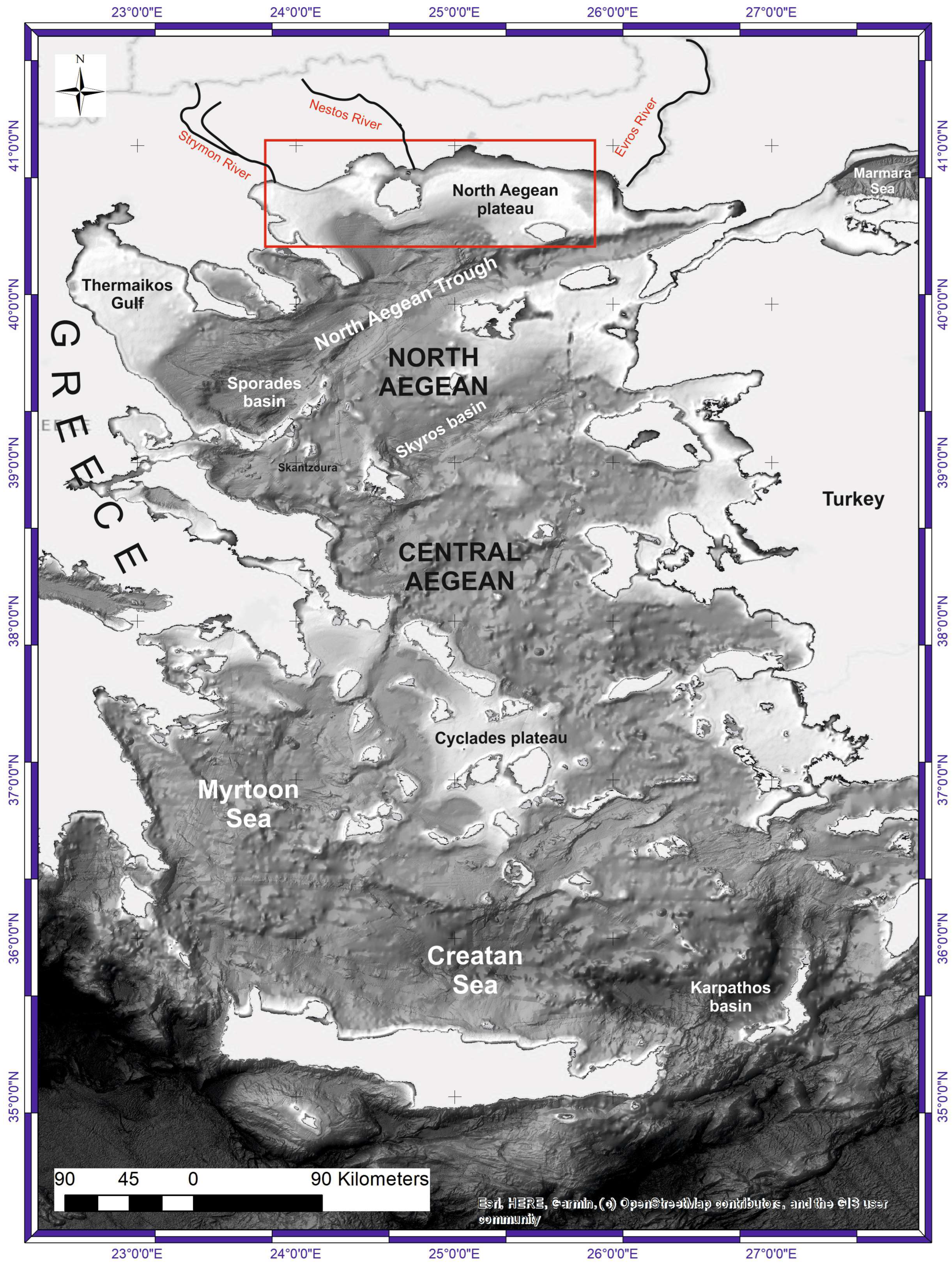
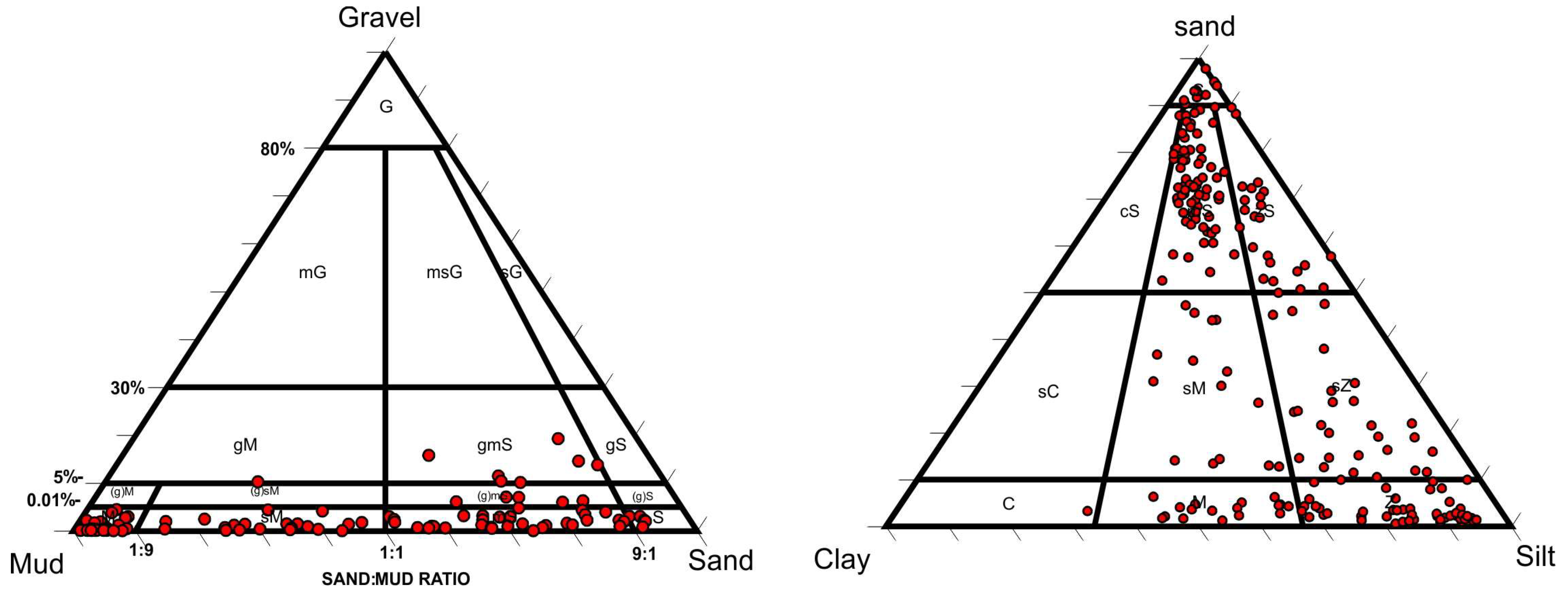
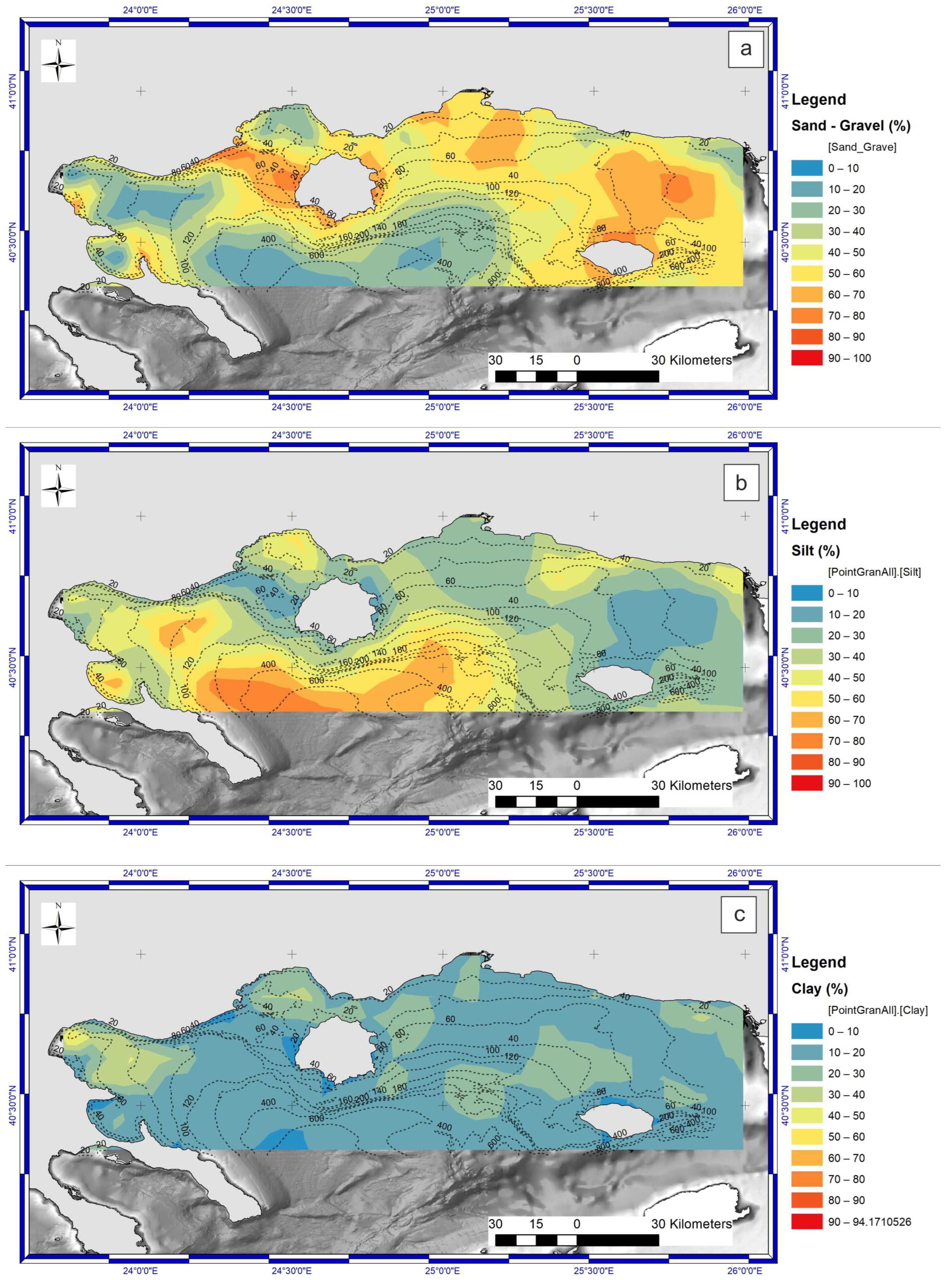


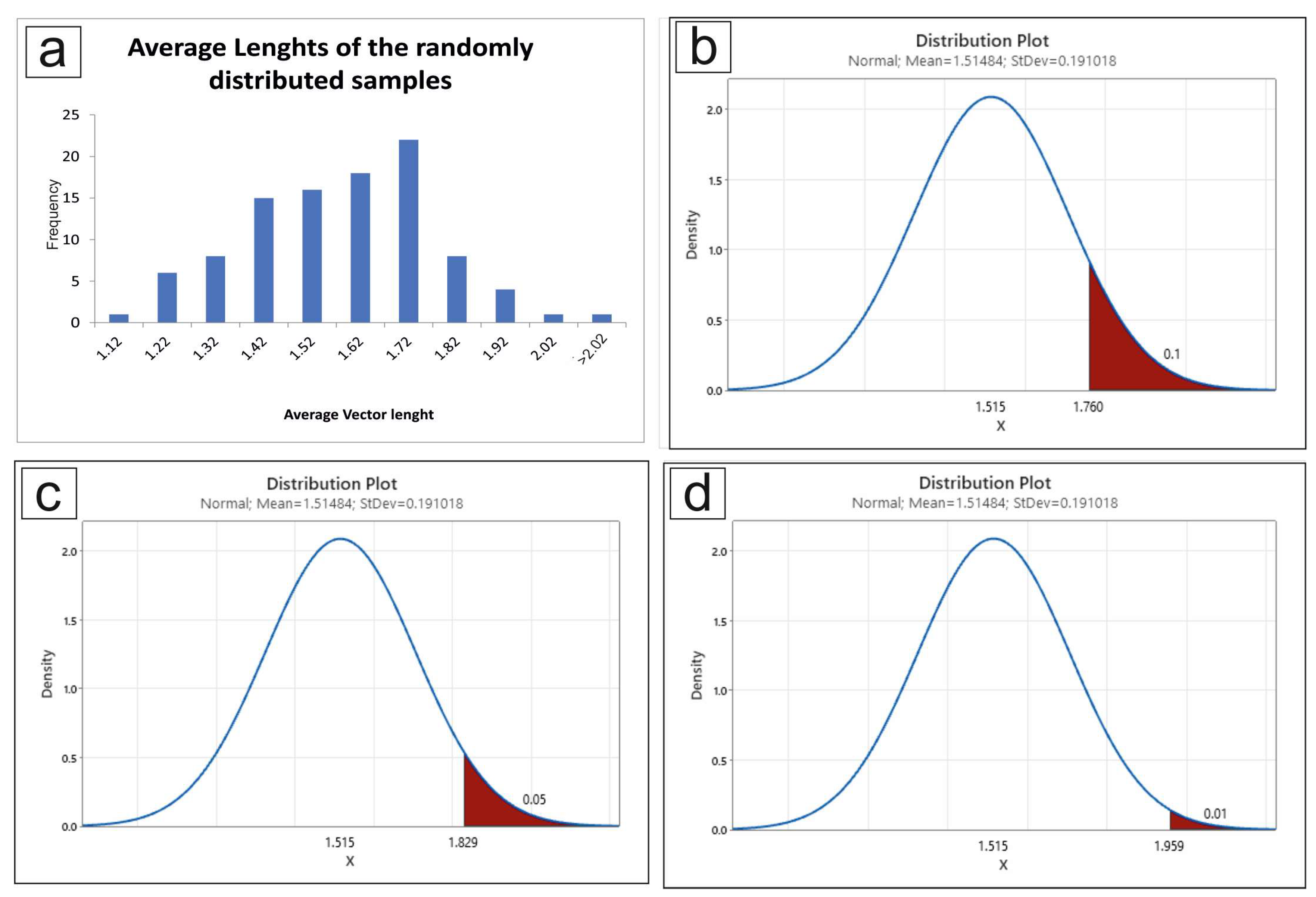
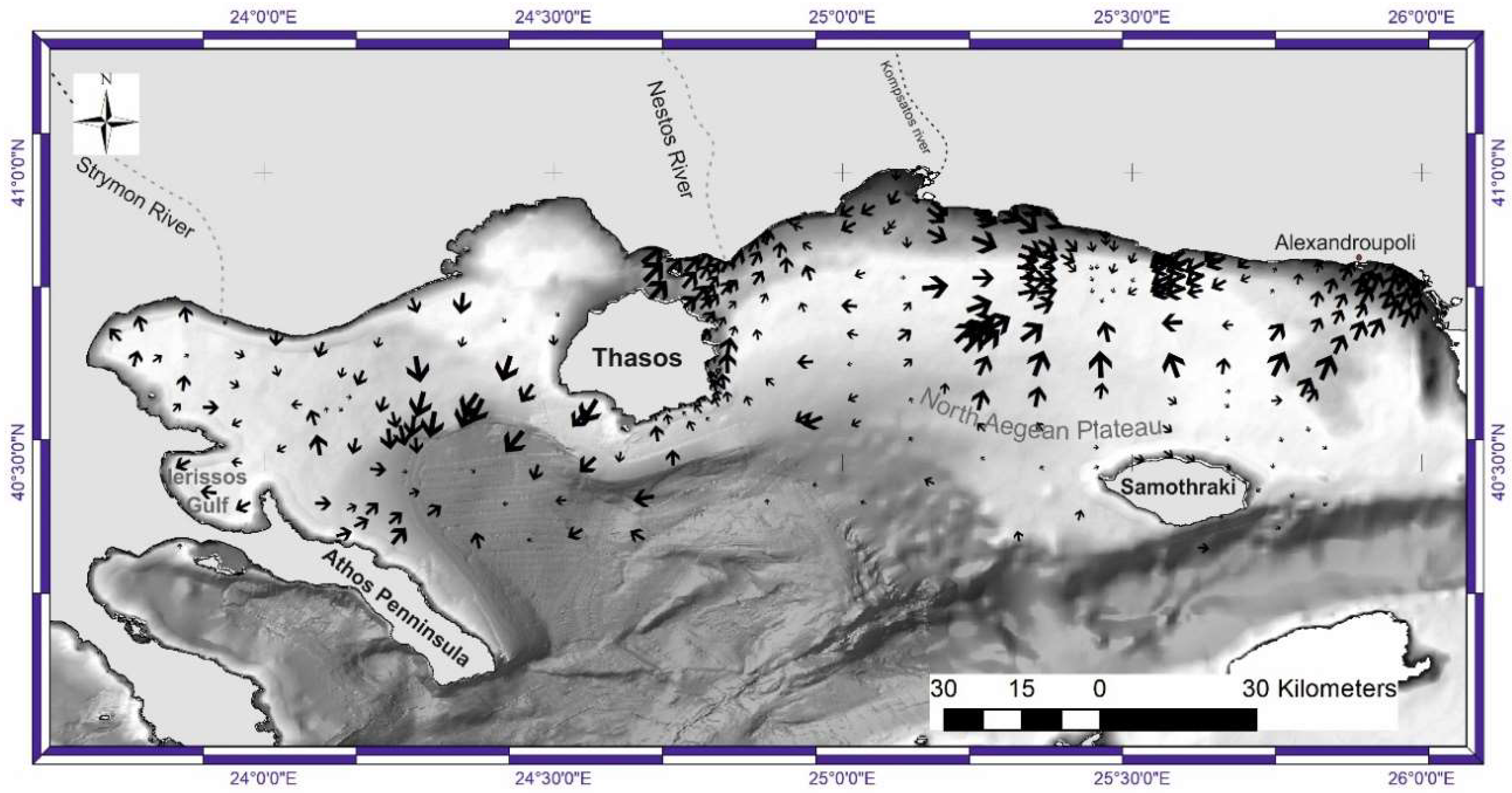

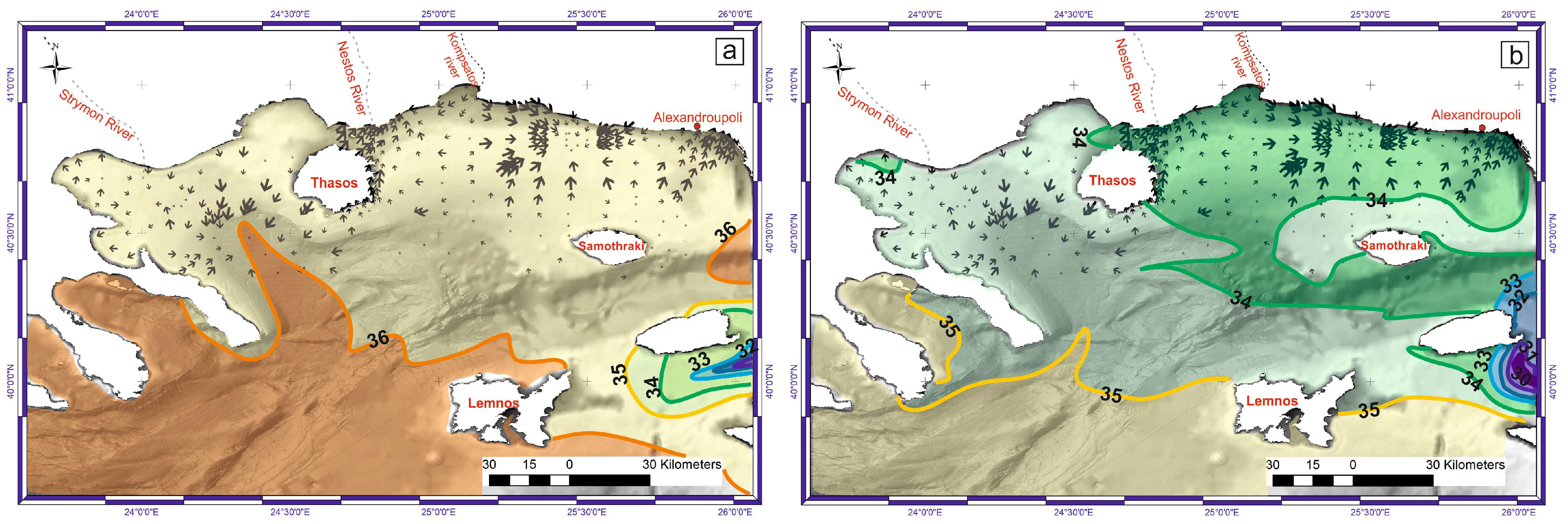
Disclaimer/Publisher’s Note: The statements, opinions and data contained in all publications are solely those of the individual author(s) and contributor(s) and not of MDPI and/or the editor(s). MDPI and/or the editor(s) disclaim responsibility for any injury to people or property resulting from any ideas, methods, instructions or products referred to in the content. |
© 2024 by the authors. Licensee MDPI, Basel, Switzerland. This article is an open access article distributed under the terms and conditions of the Creative Commons Attribution (CC BY) license (https://creativecommons.org/licenses/by/4.0/).
Share and Cite
Vakalas, I.; Zananiri, I. Net Transport Patterns of Surficial Marine Sediments in the North Aegean Sea, Greece. J. Mar. Sci. Eng. 2024, 12, 512. https://doi.org/10.3390/jmse12030512
Vakalas I, Zananiri I. Net Transport Patterns of Surficial Marine Sediments in the North Aegean Sea, Greece. Journal of Marine Science and Engineering. 2024; 12(3):512. https://doi.org/10.3390/jmse12030512
Chicago/Turabian StyleVakalas, Ioannis, and Irene Zananiri. 2024. "Net Transport Patterns of Surficial Marine Sediments in the North Aegean Sea, Greece" Journal of Marine Science and Engineering 12, no. 3: 512. https://doi.org/10.3390/jmse12030512




